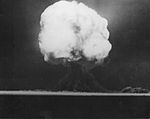Enrico Fermi
Enrico Fermi | |
|---|---|
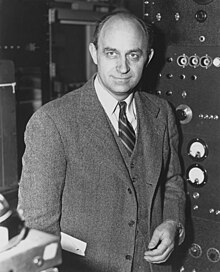 Fermi in 1943 | |
| Born | 29 September 1901 Rome, Italy |
| Died | 28 November 1954 (aged 53) Chicago, Illinois, U.S. |
| Citizenship |
|
| Alma mater | Scuola Normale Superiore di Pisa (laurea) |
| Known for |
|
| Spouse |
Laura Capon (m. 1928) |
| Children | 2 |
| Awards |
|
| Scientific career | |
| Fields | |
| Academic advisors | |
| Doctoral students |
|
| Other notable students |
|
| Signature | |
 | |
Enrico Fermi (Italian:
Fermi's first major contribution involved the field of statistical mechanics. After
Fermi left Italy in 1938 to escape new
After the war, he helped establish the
Fermi did important work in particle physics, especially related to
Early life


Enrico Fermi was born in Rome, Italy, on 29 September 1901.
At a local market in
In 1914, Fermi, who used to often meet with his father in front of the office after work, met a colleague of his father called Adolfo Amidei, who would walk part of the way home with Alberto. Enrico had learned that Adolfo was interested in mathematics and physics and took the opportunity to ask Adolfo a question about geometry. Adolfo understood that the young Fermi was referring to projective geometry and then proceeded to give him a book on the subject written by Theodor Reye. Two months later, Fermi returned the book, having solved all the problems proposed at the end of the book, some of which Adolfo considered difficult. Upon verifying this, Adolfo felt that Fermi was "a prodigy, at least with respect to geometry", and further mentored the boy, providing him with more books on physics and mathematics. Adolfo noted that Fermi had a very good memory and thus could return the books after having read them because he could remember their content very well.[15]
Scuola Normale Superiore in Pisa

Fermi graduated from high school in July 1918, having skipped the third year entirely. At Amidei's urging, Fermi learned
At the Scuola Normale Superiore, Fermi played pranks with fellow student Franco Rasetti; the two became close friends and collaborators. Fermi was advised by Luigi Puccianti, director of the physics laboratory, who said there was little he could teach Fermi and often asked Fermi to teach him something instead. Fermi's knowledge of quantum physics was such that Puccianti asked him to organize seminars on the topic.[19] During this time Fermi learned tensor calculus, a technique key to general relativity.[20] Fermi initially chose mathematics as his major, but soon switched to physics. He remained largely self-taught, studying general relativity, quantum mechanics, and atomic physics.[21]
In September 1920, Fermi was admitted to the physics department. Since there were only three students in the department—Fermi, Rasetti, and Nello Carrara—Puccianti let them freely use the laboratory for whatever purposes they chose. Fermi decided that they should research X-ray crystallography, and the three worked to produce a Laue photograph—an X-ray photograph of a crystal.[22] During 1921, his third year at the university, Fermi published his first scientific works in the Italian journal Nuovo Cimento. The first was entitled "On the dynamics of a rigid system of electrical charges in translational motion" (Sulla dinamica di un sistema rigido di cariche elettriche in moto traslatorio). A sign of things to come was that the mass was expressed as a tensor—a mathematical construct commonly used to describe something moving and changing in three-dimensional space. In classical mechanics, mass is a scalar quantity, but in relativity, it changes with velocity. The second paper was "On the electrostatics of a uniform gravitational field of electromagnetic charges and on the weight of electromagnetic charges" (Sull'elettrostatica di un campo gravitazionale uniforme e sul peso delle masse elettromagnetiche). Using general relativity, Fermi showed that a charge has a weight equal to U/c2, where U was the electrostatic energy of the system, and c is the speed of light.[21]
The first paper seemed to point out a contradiction between the electrodynamic theory and the relativistic one concerning the calculation of the electromagnetic masses, as the former predicted a value of 4/3 U/c2. Fermi addressed this the next year in a paper "Concerning a contradiction between
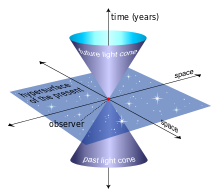
Fermi submitted his thesis, "A theorem on probability and some of its applications" (Un teorema di calcolo delle probabilità ed alcune sue applicazioni), to the Scuola Normale Superiore in July 1922, and received his laurea at the unusually young age of 20. The thesis was on X-ray diffraction images. Theoretical physics was not yet considered a discipline in Italy, and the only thesis that would have been accepted was experimental physics. For this reason, Italian physicists were slow in embracing the new ideas like relativity coming from Germany. Since Fermi was quite at home in the lab doing experimental work, this did not pose insurmountable problems for him.[25]
While writing the appendix for the Italian edition of the book Fundamentals of Einstein Relativity by
In 1924, Fermi was initiated into the
In 1923–1924, Fermi spent a semester studying under
After
Professor in Rome

Professorships in Italy were granted by competition (concorso) for a vacant chair, the applicants being rated on their publications by a committee of professors. Fermi applied for a chair of mathematical physics at the University of Cagliari on Sardinia, but was narrowly passed over in favour of Giovanni Giorgi.[32] In 1926, at the age of 24, he applied for a professorship at the Sapienza University of Rome. This was a new chair, one of the first three in theoretical physics in Italy, that had been created by the Minister of Education at the urging of professor Orso Mario Corbino, who was the university's professor of experimental physics, the director of the Institute of Physics, and a member of Benito Mussolini's cabinet. Corbino, who also chaired the selection committee, hoped that the new chair would raise the standard and reputation of physics in Italy.[33] The committee chose Fermi ahead of Enrico Persico and Aldo Pontremoli,[34] and Corbino helped Fermi recruit his team, which was soon joined by notable students such as Edoardo Amaldi, Bruno Pontecorvo, Ettore Majorana and Emilio Segrè, and by Franco Rasetti, whom Fermi had appointed as his assistant.[35] They soon nicknamed the "Via Panisperna boys" after the street where the Institute of Physics was located.[36]
Fermi married
During their time in Rome, Fermi and his group made important contributions to many practical and theoretical aspects of physics. In 1928, he published his Introduction to Atomic Physics (Introduzione alla fisica atomica), which provided Italian university students with an up-to-date and accessible text. Fermi also conducted public lectures and wrote popular articles for scientists and teachers in order to spread knowledge of the new physics as widely as possible.[44] Part of his teaching method was to gather his colleagues and graduate students together at the end of the day and go over a problem, often from his own research.[44][45] A sign of success was that foreign students now began to come to Italy. The most notable of these was the German physicist Hans Bethe,[46] who came to Rome as a Rockefeller Foundation fellow, and collaborated with Fermi on a 1932 paper "On the Interaction between Two Electrons" (German: Über die Wechselwirkung von Zwei Elektronen).[44]
At this time, physicists were puzzled by
In the introduction to the 1968 English translation, physicist Fred L. Wilson noted that:
Fermi's theory, aside from bolstering Pauli's proposal of the neutrino, has a special significance in the history of modern physics. One must remember that only the naturally occurring β emitters were known at the time the theory was proposed. Later when positron decay was discovered, the process was easily incorporated within Fermi's original framework. On the basis of his theory, the capture of an orbital electron by a nucleus was predicted and eventually observed. With time, experimental data accumulated significantly. Although peculiarities have been observed many times in β decay, Fermi's theory always has been equal to the challenge.
The consequences of the Fermi theory are vast. For example, β spectroscopy was established as a powerful tool for the study of nuclear structure. But perhaps the most influential aspect of this work of Fermi is that his particular form of the β interaction established a pattern that has been appropriate for the study of other types of interactions. It was the first successful theory of the creation and annihilation of material particles. Previously, only photons had been known to be created and destroyed.[49]
In January 1934,
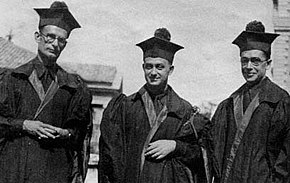
Fermi had the idea to resort to replacing the polonium-beryllium neutron source with a radon-beryllium one, which he created by filling a glass bulb with beryllium powder, evacuating the air, and then adding 50 mCi of radon gas, supplied by Giulio Cesare Trabacchi.[56][57] This created a much stronger neutron source, the effectiveness of which declined with the 3.8-day half-life of radon. He knew that this source would also emit gamma rays, but, on the basis of his theory, he believed that this would not affect the results of the experiment. He started by bombarding platinum, an element with a high atomic number that was readily available, without success. He turned to aluminium, which emitted an alpha particle and produced sodium, which then decayed into magnesium by beta particle emission. He tried lead, without success, and then fluorine in the form of calcium fluoride, which emitted an alpha particle and produced nitrogen, decaying into oxygen by beta particle emission. In all, he induced radioactivity in 22 different elements.[58] Fermi rapidly reported the discovery of neutron-induced radioactivity in the Italian journal La Ricerca Scientifica on 25 March 1934.[57][59][60]
The natural radioactivity of thorium and uranium made it hard to determine what was happening when these elements were bombarded with neutrons but, after correctly eliminating the presence of elements lighter than uranium but heavier than lead, Fermi concluded that they had created new elements, which he called ausenium and hesperium.[61][55] The chemist Ida Noddack suggested that some of the experiments could have produced lighter elements than lead rather than new, heavier elements. Her suggestion was not taken seriously at the time because her team had not carried out any experiments with uranium or built the theoretical basis for this possibility. At that time, fission was thought to be improbable if not impossible on theoretical grounds. While physicists expected elements with higher atomic numbers to form from neutron bombardment of lighter elements, nobody expected neutrons to have enough energy to split a heavier atom into two light element fragments in the manner that Noddack suggested.[62][61]

The Via Panisperna boys also noticed some unexplained effects. The experiment seemed to work better on a wooden table than on a marble tabletop. Fermi remembered that Joliot-Curie and Chadwick had noted that
In 1938, Fermi received the Nobel Prize in Physics at the age of 37 for his "demonstrations of the existence of new radioactive elements produced by neutron irradiation, and for his related discovery of nuclear reactions brought about by slow neutrons".[65] After Fermi received the prize in Stockholm, he did not return home to Italy but rather continued to New York City with his family in December 1938, where they applied for permanent residency. The decision to move to America and become US citizens was due primarily to the racial laws in Italy.[39][66]
Manhattan Project

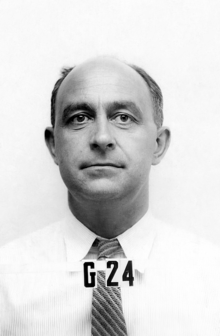
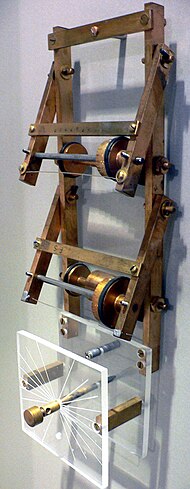
Fermi arrived in New York City on 2 January 1939.
I remember very vividly the first month, January, 1939, that I started working at the Pupin Laboratories because things began happening very fast. In that period, Niels Bohr was on a lecture engagement at the Princeton University and I remember one afternoon Willis Lamb came back very excited and said that Bohr had leaked out great news. The great news that had leaked out was the discovery of fission and at least the outline of its interpretation. Then, somewhat later that same month, there was a meeting in Washington where the possible importance of the newly discovered phenomenon of fission was first discussed in semi-jocular earnest as a possible source of nuclear power.[74]
Noddack was proven right after all. Fermi had dismissed the possibility of fission on the basis of his calculations, but he had not taken into account the
The scientists at Columbia decided that they should try to detect the energy released in the nuclear fission of uranium when bombarded by neutrons. On 25 January 1939, in the basement of
French scientists
Fermi was among the first to warn military leaders about the potential impact of nuclear energy, giving a lecture on the subject at the
The Advisory Committee on Uranium provided money for Fermi to buy graphite,[86] and he built a pile of graphite bricks on the seventh floor of the Pupin Hall laboratory.[87] By August 1941, he had six tons of uranium oxide and thirty tons of graphite, which he used to build a still larger pile in Schermerhorn Hall at Columbia.[88]
The S-1 Section of the Office of Scientific Research and Development, as the Advisory Committee on Uranium was now known, met on 18 December 1941, with the US now engaged in World War II, making its work urgent. Most of the effort sponsored by the committee had been directed at producing enriched uranium, but Committee member Arthur Compton determined that a feasible alternative was plutonium, which could be mass-produced in nuclear reactors by the end of 1944.[89] He decided to concentrate the plutonium work at the University of Chicago. Fermi reluctantly moved, and his team became part of the new Metallurgical Laboratory there.[90]
The possible results of a self-sustaining nuclear reaction were unknown, so it seemed inadvisable to build the first nuclear reactor on the University of Chicago campus in the middle of the city. Compton found a location in the Argonne Woods Forest Preserve, about 20 miles (32 km) from Chicago. Stone & Webster was contracted to develop the site, but the work was halted by an industrial dispute. Fermi then persuaded Compton that he could build the reactor in the squash court under the stands of the University of Chicago's Stagg Field. Construction of the pile began on 6 November 1942, and Chicago Pile-1 went critical on 2 December.[91] The shape of the pile was intended to be roughly spherical, but as work proceeded Fermi calculated that criticality could be achieved without finishing the entire pile as planned.[92]
This experiment was a landmark in the quest for energy, and it was typical of Fermi's approach. Every step was carefully planned, and every calculation was meticulously done.[91] When the first self-sustained nuclear chain reaction was achieved, Compton made a coded phone call to James B. Conant, the chairman of the National Defense Research Committee.
I picked up the phone and called Conant. He was reached at the President's office at Harvard University. "Jim," I said, "you'll be interested to know that the Italian navigator has just landed in the new world." Then, half apologetically, because I had led the S-l Committee to believe that it would be another week or more before the pile could be completed, I added, "the earth was not as large as he had estimated, and he arrived at the new world sooner than he had expected."
"Is that so," was Conant's excited response. "Were the natives friendly?"
"Everyone landed safe and happy."[93]
To continue the research where it would not pose a public health hazard, the reactor was disassembled and moved to the Argonne Woods site. There Fermi directed experiments on nuclear reactions, reveling in the opportunities provided by the reactor's abundant production of free neutrons.[94] The laboratory soon branched out from physics and engineering into using the reactor for biological and medical research. Initially, Argonne was run by Fermi as part of the University of Chicago, but it became a separate entity with Fermi as its director in May 1944.[95]
When the air-cooled X-10 Graphite Reactor at Oak Ridge went critical on 4 November 1943, Fermi was on hand just in case something went wrong. The technicians woke him early so that he could see it happen.[96] Getting X-10 operational was another milestone in the plutonium project. It provided data on reactor design, training for DuPont staff in reactor operation, and produced the first small quantities of reactor-bred plutonium.[97] Fermi became an American citizen in July 1944, the earliest date the law allowed.[98]
In September 1944, Fermi inserted the first uranium fuel slug into the B Reactor at the Hanford Site, the production reactor designed to breed plutonium in large quantities. Like X-10, it had been designed by Fermi's team at the Metallurgical Laboratory and built by DuPont, but it was much larger and was water-cooled. Over the next few days, 838 tubes were loaded, and the reactor went critical. Shortly after midnight on 27 September, the operators began to withdraw the control rods to initiate production. At first, all appeared to be well, but around 03:00, the power level started to drop and by 06:30 the reactor had shut down completely. The Army and DuPont turned to Fermi's team for answers. The cooling water was investigated to see if there was a leak or contamination. The next day the reactor suddenly started up again, only to shut down once more a few hours later. The problem was traced to neutron poisoning from xenon-135 or Xe-135, a fission product with a half-life of 9.1 to 9.4 hours. Fermi and John Wheeler both deduced that Xe-135 was responsible for absorbing neutrons in the reactor, thereby sabotaging the fission process. Fermi was recommended by colleague Emilio Segrè to ask Chien-Shiung Wu, as she prepared a printed draft on this topic to be published by the Physical Review.[99] Upon reading the draft, Fermi and the scientists confirmed their suspicions: Xe-135 indeed absorbed neutrons, in fact it had a huge neutron cross-section.[100][101][102] DuPont had deviated from the Metallurgical Laboratory's original design in which the reactor had 1,500 tubes arranged in a circle, and had added 504 tubes to fill in the corners. The scientists had originally considered this over-engineering a waste of time and money, but Fermi realized that if all 2,004 tubes were loaded, the reactor could reach the required power level and efficiently produce plutonium.[103][104]
In April 1943, Fermi raised with
In mid-1944, Oppenheimer persuaded Fermi to join his
Along with Oppenheimer, Compton, and Ernest Lawrence, Fermi was part of the scientific panel that advised the Interim Committee on target selection. The panel agreed with the committee that atomic bombs would be used without warning against an industrial target.[109] Like others at the Los Alamos Laboratory, Fermi found out about the atomic bombings of Hiroshima and Nagasaki from the public address system in the technical area. Fermi did not believe that atomic bombs would deter nations from starting wars, nor did he think that the time was ripe for world government. He therefore did not join the Association of Los Alamos Scientists.[110]
Postwar work
Fermi became the Charles H. Swift Distinguished Professor of Physics at the University of Chicago on 1 July 1945,
The Manhattan Project was replaced by the Atomic Energy Commission (AEC) on 1 January 1947.[117] Fermi served on the AEC General Advisory Committee, an influential scientific committee chaired by Robert Oppenheimer.[118] He also liked to spend a few weeks each year at the Los Alamos National Laboratory,[119] where he collaborated with Nicholas Metropolis,[120] and with John von Neumann on Rayleigh–Taylor instability, the science of what occurs at the border between two fluids of different densities.[121]
After the detonation of the first Soviet
In his later years, Fermi continued teaching at the University of Chicago, where he was a founder of what later became the
Fermi wrote a paper "On the Origin of

Toward the end of his life, Fermi questioned his faith in society at large to make wise choices about nuclear technology. He said:
Some of you may ask, what is the good of working so hard merely to collect a few facts which will bring no pleasure except to a few long-haired professors who love to collect such things and will be of no use to anybody because only few specialists at best will be able to understand them? In answer to such question[s] I may venture a fairly safe prediction.
The history of science and technology has consistently taught us that scientific advances in basic understanding have sooner or later led to technical and industrial applications that have revolutionized our way of life. It seems to me improbable that this effort to get at the structure of matter should be an exception to this rule. What is less certain, and what we all fervently hope, is that man will soon grow sufficiently adult to make good use of the powers that he acquires over nature.[133]
Death
Fermi underwent what was called an "exploratory" operation in Billings Memorial Hospital in October 1954, after which he returned home. Fifty days later he died of inoperable stomach cancer in his home in Chicago. He was 53.[2] Fermi suspected working near the nuclear pile involved great risk but he pressed on because he felt the benefits outweighed the risks to his personal safety. Two of his graduate student assistants working near the pile also died of cancer.[134]
A memorial service was held at the
Impact and legacy
Legacy
Fermi received numerous awards in recognition of his achievements, including the
Fermi was known as an inspiring teacher and was noted for his attention to detail, simplicity, and careful preparation of his lectures.
Fermi was fond of pointing out that when Alessandro Volta was working in his laboratory, Volta had no idea where the study of electricity would lead.[148] Fermi is generally remembered for his work on nuclear power and nuclear weapons, especially the creation of the first nuclear reactor, and the development of the first atomic and hydrogen bombs. His scientific work has stood the test of time. This includes his theory of beta decay, his work with non-linear systems, his discovery of the effects of slow neutrons, his study of pion-nucleon collisions, and his Fermi–Dirac statistics. His speculation that a pion was not a fundamental particle pointed the way towards the study of quarks and leptons.[149]
As a person, Fermi seemed simplicity itself. He was extraordinarily vigorous and loved games and sport. On such occasions his ambitious nature became apparent. He played tennis with considerable ferocity and when climbing mountains acted rather as a guide. One might have called him a benevolent dictator. I remember once at the top of a mountain Fermi got up and said: "Well, it is two minutes to two, let's all leave at two o'clock"; and of course, everybody got up faithfully and obediently. This leadership and self-assurance gave Fermi the name of "The Pope" whose pronouncements were infallible in physics. He once said: "I can calculate anything in physics within a factor 2 on a few sheets; to get the numerical factor in front of the formula right may well take a physicist a year to calculate, but I am not interested in that." His leadership could go so far that it was a danger to the independence of the person working with him. I recollect once, at a party at his house when my wife cut the bread, Fermi came along and said he had a different philosophy on bread-cutting and took the knife out of my wife's hand and proceeded with the job because he was convinced that his own method was superior. But all this did not offend at all, but rather charmed everybody into liking Fermi. He had very few interests outside physics and when he once heard me play on Teller's piano he confessed that his interest in music was restricted to simple tunes.
Things named after Fermi
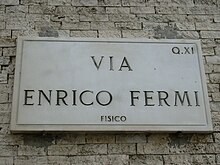
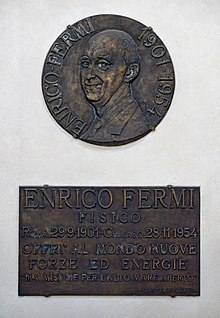
Many things bear Fermi's name. These include the
Since 1956, the United States Atomic Energy Commission has named its highest honor, the
Publications
- Introduzione alla Fisica Atomica (in Italian). Bologna: N. OCLC 9653646.
- Fisica per i Licei (in Italian). Bologna: N. Zanichelli. 1929. OCLC 9653646.
- Molecole e cristalli (in Italian). Bologna: N. Zanichelli. 1934. OCLC 19918218.
- Thermodynamics. New York: Prentice Hall. 1937. OCLC 2379038.
- Fisica per Istituti Tecnici (in Italian). Bologna: N. Zanichelli. 1938.
- Fisica per Licei Scientifici (in Italian). Bologna: N. Zanichelli. 1938. (with Edoardo Amaldi)
- Elementary particles. New Haven: Yale University Press. 1951. OCLC 362513.
- Notes on Quantum Mechanics. Chicago: The University of Chicago Press. 1961. OCLC 1448078.
For a full list of his papers, see pages 75–78 in ref.[139]
Patents
- US Patent 2206634, "Process for the Production of Radioactive Substances", issued July 1940
- US Patent 2836554, "Air Cooled Neutronic Reactor", issued April 1950
- US Patent 2524379, "Neutron Velocity Selector", issued October 1950
- US Patent 2852461, "Neutronic Reactor", issued September 1953
- US Patent 2708656, "Neutronic Reactor", issued May 1955
- US Patent 2768134, "Testing Material in a Neutronic Reactor", issued October 1956
- US Patent 2780595, "Test Exponential Pile", issued February 1957
- US Patent 2798847, "Method of Operating a Neutronic Reactor", issued July 1957
- US Patent 2807581, "Neutronic Reactor", issued September 1957
- US Patent 2807727, "Neutronic Reactor Shield", issued September 1957
- US Patent 2813070, "Method of Sustaining a Neutronic Chain Reacting System", issued November 1957
- US Patent 2837477, "Chain Reacting System", issued June 1958
- US Patent 2931762, "Neutronic Reactor", issued April 1960
- US Patent 2969307, "Method of Testing Thermal Neutron Fissionable Material for Purity", issued January 1961
References
- ^ "Enrico Fermi, architect of the nuclear age, dies". Autumn 1954. Archived from the original on 17 November 2015. Retrieved 2 November 2015.
- ^ a b "Enrico Fermi Dead at 53; Architect of Atomic Bomb". The New York Times. 29 November 1954. Archived from the original on 14 March 2019. Retrieved 21 January 2013.
- ^ a b "Portale Antenati". Portale Antenati (in Italian). Retrieved 23 May 2023.
- ^ Segrè 1970, pp. 3–4, 8.
- ^ Amaldi 2001, p. 23.
- ^ Cooper 1999, p. 19.
- ISBN 9780226149653.
- ^ Segrè 1970, pp. 5–6.
- ^ Fermi 1954, pp. 15–16.
- ^ "Maria Fermi Sacchetti (1899–1959)". www.OlgiateOlona26giugno1959.org (in Italian). Archived from the original on 30 August 2017. Retrieved 6 May 2017.
- ^ Segrè 1970, p. 7.
- ^ Bonolis 2001, p. 315.
- ^ Amaldi 2001, p. 24.
- ^ Segrè 1970, pp. 11–12.
- ^ Segrè 1970, pp. 8–10.
- ^ a b Segrè 1970, pp. 11–13.
- ^ Fermi 1954, pp. 20–21.
- ^ "Edizione Nazionale Mathematica Italiana – Giulio Pittarelli" (in Italian). Scuola Normale Superiore. Archived from the original on 17 December 2017. Retrieved 6 May 2017.
- ^ Segrè 1970, pp. 15–18.
- ^ Bonolis 2001, p. 320.
- ^ a b Bonolis 2001, pp. 317–319.
- ^ Segrè 1970, p. 20.
- ^ "Über einen Widerspruch zwischen der elektrodynamischen und relativistischen Theorie der elektromagnetischen Masse". Physikalische Zeitschrift (in German). 23: 340–344. Archived from the original on 3 February 2021. Retrieved 17 January 2013.
- ^ Bertotti 2001, p. 115.
- ^ a b c Bonolis 2001, p. 321.
- ^ Service, Multimedia. "[as] radici – Le masse nella teoria della relatività (1923)". Asimmetrie (in Italian). Retrieved 23 July 2023.
- ^ "Enrico Fermi L'Uomo, lo Scienziato e il Massone" (in Italian). Archived from the original on 20 March 2016. Retrieved 4 March 2015.
- ^ Bonolis 2001, pp. 321–324.
- ^ Hey & Walters 2003, p. 61.
- ^ Bonolis 2001, pp. 329–330.
- ^ Cooper 1999, p. 31.
- ^ Fermi 1954, pp. 37–38.
- ^ Segrè 1970, p. 45.
- ^ Fermi 1954, p. 38.
- ^ a b Alison 1957, p. 127.
- ^ "Enrico Fermi e i ragazzi di via Panisperna" (in Italian). University of Rome. Archived from the original on 20 February 2021. Retrieved 20 January 2013.
- ^ Segrè 1970, p. 61.
- ^ Cooper 1999, pp. 38–39.
- ^ a b Alison 1957, p. 130.
- ^ "About Enrico Fermi". University of Chicago. Archived from the original on 21 December 2011. Retrieved 20 January 2013.
- ^ Mieli, Paolo (2 October 2001). "Così Fermi scoprì la natura vessatoria del fascismo". Corriere della Sera (in Italian). Archived from the original on 19 October 2013. Retrieved 20 January 2013.
- ^ Direzione generale per gli archivi (2005). "Reale accademia d'Italia:inventario dell'archivio" (PDF) (in Italian). Rome: Ministero per i beni culturali e ambientali. p. xxxix. Archived from the original (PDF) on 7 September 2012. Retrieved 20 January 2013.
- ^ "A Legal Examination of Mussolini's Race Laws". Printed Matter. Centro Primo Levi. Archived from the original on 17 August 2015. Retrieved 7 August 2015.
- ^ a b c Bonolis 2001, pp. 333–335.
- ^ Amaldi 2001, p. 38.
- ^ Fermi 1954, p. 217.
- ^ Amaldi 2001, pp. 50–51.
- ^ a b Bonolis 2001, p. 346.
- ^ from the original on 12 May 2013. Retrieved 20 January 2013.
- ^ Schwartz 2021, p. 154.
- ^ Joliot-Curie, Irène; Joliot, Frédéric (15 January 1934). "Un nouveau type de radioactivité" [A new type of radioactivity]. Comptes Rendus Hebdomadaires des Séances de l'Académie des Sciences (in French). 198 (January–June 1934): 254–256. Archived from the original on 20 February 2021. Retrieved 19 October 2013.
- (PDF) from the original on 23 November 2020. Retrieved 19 October 2013.
- ^ Amaldi 2001a, pp. 152–153.
- ^ Bonolis 2001, pp. 347–351.
- ^ a b c d Amaldi 2001a, pp. 153–156.
- ^ Segrè 1970, p. 73.
- ^ S2CID 119489980.
- S2CID 120707438.
- ^ Fermi, Enrico (25 March 1934). "Radioattività indotta da bombardamento di neutroni". La Ricerca Scientifica (in Italian). 1 (5): 283. Archived from the original on 24 February 2021. Retrieved 20 October 2013.
- .
- ^ a b Bonolis 2001, pp. 347–349.
- ^ a b Amaldi 2001a, pp. 161–162.
- ^ a b Bonolis 2001, pp. 347–352.
- ^ "A Few Good Moderators: The Numbers". The Energy From Thorium Foundation. 13 February 2007. Archived from the original on 24 February 2021. Retrieved 24 September 2013.
- ^ Cooper 1999, p. 51.
- ^ Sullivan 2016, p. 19.
- ^ Cooper 1999, p. 52.
- ^ Persico 2001, p. 40.
- ^ Bonolis 2001, p. 352.
- S2CID 5920336.
- S2CID 4076376.
- from the original on 28 April 2019. Retrieved 17 March 2008.
- ^ a b Rhodes 1986, p. 267.
- ^ Segrè 1970, pp. 222–223.
- ^ a b Enrico Fermi on Nobelprize.org including the Nobel Lecture, 12 December 1938 Artificial Radioactivity Produced by Neutron Bombardment
- .
- ^ Rhodes 1986, pp. 269–270.
- S2CID 4089039.
- .
- from the original on 8 June 2020. Retrieved 20 November 2015.
- ^ from the original on 25 February 2021. Retrieved 19 October 2013.
- ^ Salvetti 2001, pp. 186–188.
- ^ Bonolis 2001, pp. 356–357.
- ^ Salvetti 2001, p. 185.
- ^ Salvetti 2001, pp. 188–189.
- ^ Rhodes 1986, pp. 314–317.
- ^ Salvetti 2001, p. 190.
- ^ Salvetti 2001, p. 195.
- ^ Salvetti 2001, pp. 194–196.
- ^ Rhodes 1986, pp. 399–400.
- ^ a b Salvetti 2001, pp. 198–202.
- JSTOR 3301034.
- ^ Compton 1956, p. 144.
- ^ Bonolis 2001, p. 366.
- ^ Hewlett & Anderson 1962, p. 207.
- ^ Hewlett & Anderson 1962, pp. 208–211.
- ^ Jones 1985, p. 205.
- ^ Segrè 1970, p. 104.
- ^ Dicke, William (18 February 1997). "Chien-Shiung Wu, 84, Top Experimental Physicist". Archived from the original on 14 July 2010. Retrieved 12 March 2021.
- ^ Benczer-Koller, Noemie (January 2009). "Chien-shiungwu 1912–1997" (PDF). Archived (PDF) from the original on 26 March 2015. Retrieved 12 March 2021.
- ISBN 9789811206306. Archivedfrom the original on 30 May 2021. Retrieved 3 May 2021.
- ^ Chiang, T.-C. (27 November 2012). "Inside Story: C S Wu – First Lady of physics research". CERN Courier. Archived from the original on 12 June 2018. Retrieved 5 April 2014.
- ^ Hewlett & Anderson 1962, pp. 304–307.
- ^ Jones 1985, pp. 220–223.
- ^ Rhodes 1986, pp. 510–511.
- ^ Bonolis 2001, pp. 368–369.
- ^ Hawkins 1961, p. 213.
- ^ Rhodes 1986, pp. 674–677.
- ^ Jones 1985, pp. 531–532.
- ^ Fermi 1954, pp. 244–245.
- ^ Segrè 1970, p. 157.
- ^ Segrè 1970, p. 167.
- ^ ""Enrico Fermi" on NASOnline.org". Archived from the original on 25 February 2016. Retrieved 18 February 2016.
- ^ Holl, Hewlett & Harris 1997, pp. xix–xx.
- ^ Segrè 1970, p. 171.
- ^ Segrè 1970, p. 172.
- ^ Hewlett & Anderson 1962, p. 643.
- ^ Hewlett & Anderson 1962, p. 648.
- ^ Segrè 1970, p. 175.
- ^ a b Segrè 1970, p. 179.
- ^ Bonolis 2001, p. 381.
- ^ Hewlett & Duncan 1969, pp. 380–385.
- ^ Hewlett & Duncan 1969, pp. 527–530.
- ^ Cooper 1999, pp. 102–103.
- ^ Enrico Fermi at the Mathematics Genealogy Project
- ^ "Jack Steinberger – Biographical". Nobel Foundation. Archived from the original on 4 October 2013. Retrieved 15 August 2013.
- ^ Cornish, Audie (24 November 2014). "'Queen Of Carbon' Among Medal Of Freedom Honorees". All Things Considered. NPR. Archived from the original on 30 September 2018. Retrieved 30 September 2018.
- ^ a b Bonolis 2001, pp. 374–379.
- .
- ^ Jacob & Maiani 2001, pp. 254–258.
- ^ Bonolis 2001, p. 386.
- ^ Jones 1985a, pp. 1–3.
- ^ Fermi 2004, p. 142.
- ^ "The Life of Enrico Fermi". 12 December 2022. Retrieved 16 December 2022.
- .
- ^ Hucke & Bielski 1999, pp. 147, 150.
- ^ Alison 1957, pp. 135–136.
- ^ "APS Member History". search.amphilsoc.org. Retrieved 8 May 2023.
- ^ JSTOR 769243.
- ^ "Enrico Fermi in Santa Croce, Florence". gotterdammerung.org. Retrieved 10 May 2015.
- ^ "Time 100 Persons of the Century". Time. 6 June 1999. Archived from the original on 11 February 2001. Retrieved 2 March 2013.
- ^ Snow 1981, p. 79.
- ^ Ricci 2001, pp. 297–302.
- ^ Ricci 2001, p. 286.
- ^ "Enrico Fermi Collection". University of Chicago. Archived from the original on 18 March 2021. Retrieved 22 January 2013.
- ^ Salvini 2001, p. 5.
- ^ Von Baeyer 1993, pp. 3–8.
- ^ Fermi 1954, p. 242.
- ^ Salvini 2001, p. 17.
- ^ "About Fermilab – History". Fermilab. Archived from the original on 14 September 2012. Retrieved 21 January 2013.
- National Aeronautics and Space Administration. Archivedfrom the original on 1 October 2012. Retrieved 21 January 2013.
- ^ "Nuclear Power in Italy". World Nuclear Association. Archived from the original on 11 June 2020. Retrieved 21 January 2013.
- CNEA. November 2004. Archived from the original(PDF) on 14 May 2013. Retrieved 21 January 2013.
- ^ Seaborg 1978, p. 2.
- ^ Hoff 1978, pp. 39–48.
- ^ Kevin A. Boudreaux. "Derivations of the Names and Symbols of the Elements". Angelo State University. Archived from the original on 3 December 2017. Retrieved 11 February 2017.
- ^ "The Enrico Fermi Award". United States Department of Energy. Archived from the original on 13 December 2013. Retrieved 25 August 2010.
Sources
- (PDF) from the original on 16 December 2021. Retrieved 4 December 2021.
- OCLC 56686431.
- Amaldi, Ugo (2001). "Nuclear Physics from the Nineteen Thirties to the Present Day". In Bernardini, C.; Bonolis, Luisa (eds.). Enrico Fermi: His Work and Legacy. Bologna: Società Italiana di Fisica: Springer. pp. 151–176. OCLC 56686431.
- Bertotti, Bruno (2001). "Fermi's Coordinates and the Principle of Equivalence". In Bernardini, C.; Bonolis, Luisa (eds.). Enrico Fermi: His Work and Legacy. Bologna: Società Italiana di Fisica: Springer. pp. 115–125. OCLC 56686431.
- Bonolis, Luisa (2001). "Enrico Fermi's Scientific Work". In Bernardini, C.; Bonolis, Luisa (eds.). Enrico Fermi: His Work and Legacy. Bologna: Società Italiana di Fisica: Springer. pp. 314–394. OCLC 56686431.
- OCLC 173307.
- Cooper, Dan (1999). Enrico Fermi: And the Revolutions in Modern physics. New York: Oxford University Press. OCLC 39508200.
- Fermi, Enrico (2004). "The Future of Nuclear Physics". In Cronin, J.W (ed.). Fermi Remembered. Chicago: University of Chicago Press. ISBN 978-0-226-12111-6.
- OCLC 537507.
- Hawkins, David (1961). Manhattan District History: Project Y – The Los Alamos Project. Volume I: Inception until August 1945. Los Alamos: Los Alamos National Laboratory. LAMS 2532.
- Hoff, Richard (23 January 1978). "Production of Eisteinium and Fermium in Nuclear Explosions". In Seaborg, Glenn T (ed.). Proceedings of the Symposium Commemorating the 25th Anniversary of Elements 99 and 100 (PDF). Los Alamos: Los Alamos National Laboratory. pp. 39–49. Report LBL-7701. Archived (PDF) from the original on 16 September 2011. Retrieved 20 January 2013.
- (PDF) from the original on 26 September 2019. Retrieved 2 April 2018.
- Hewlett, Richard G.; Duncan, Francis (1969). Atomic Shield, 1947–1952. A History of the United States Atomic Energy Commission. University Park: Pennsylvania State University Press. OCLC 3717478.
- OCLC 50252084.
- Holl, Jack M.; ISBN 978-0-252-02341-5.
- Hucke, Matt; Bielski, Ursula (1999). Graveyards of Chicago: The People, History, Art, and Lore of Cook County Cemeteries. Chicago: Lake Claremont Press. OCLC 42849992.
- Jacob, Maurice; Maiani, Luciano (2001). "The Scientific Legacy of Fermi in Particle Physics". In Bernardini, C.; Bonolis, Luisa (eds.). Enrico Fermi: His Work and Legacy. Bologna: Società Italiana di Fisica: Springer. pp. 241–270. OCLC 56686431.
- Jones, Eric M. (March 1985). "Where is Everybody?", An Account of Fermi's Question (PDF). Los Alamos: OCLC 4434691994. LA-10311-MS. Archived(PDF) from the original on 5 November 2015. Retrieved 20 November 2015.
- Jones, Vincent (1985). Manhattan: The Army and the Atomic Bomb. Washington, D.C.: United States Army Center of Military History. OCLC 10913875.
- OCLC 56686431.
- OCLC 13793436.
- Ricci, Renato Angelo (2001). "Fermi's Last Lessons". In Bernardini, C.; Bonolis, Luisa (eds.). Enrico Fermi: His Work and Legacy. Bologna: Società Italiana di Fisica: Springer. pp. 286–313. OCLC 56686431.
- Salvini, Giorgio (2001). "Enrico Fermi: His Life and Comment on his Work". In Bernardini, C.; Bonolis, Luisa (eds.). Enrico Fermi: His Work and Legacy. Bologna: Società Italiana di Fisica: Springer. pp. 1–20. OCLC 56686431.
- Salvetti, Carlo (2001). "The Birth of Nuclear Energy: Fermi's Pile". In Bernardini, C.; Bonolis, Luisa (eds.). Enrico Fermi: His Work and Legacy. Bologna: Società Italiana di Fisica: Springer. pp. 177–203. OCLC 56686431.
- Schwartz, David N. (2021). L'ultimo uomo che sapeva tutto [The Last Man Who Knew Everything] (in Italian). Milan: Solferino, RCS MediaGroup. ISBN 978-88-282-0390-2.
- Seaborg, Glenn T. (23 January 1978). "Introductory Remarks". In Seaborg, Glenn T (ed.). Proceedings of the Symposium Commemorating the 25th Anniversary of Elements 99 and 100 (PDF). Los Alamos: Los Alamos National Laboratory. pp. 1–3. Report LBL-7701. Archived (PDF) from the original on 16 September 2011. Retrieved 20 January 2013.
- OCLC 118467.
- OCLC 7722354.
- Sullivan, Neil J. (2016). The Prometheus Bomb: The Manhattan Project and Government in the Dark. Lincoln: ISBN 978-1-61234-890-2. Archivedfrom the original on 1 December 2021. Retrieved 4 December 2021.
- Von Baeyer, H. C. (1993). The Fermi Solution: Essays on Science. New York: Random House. OCLC 27266040.
Further reading
- Bernstein, Barton J. "Four Physicists and the Bomb: The Early Years, 1945-1950" Historical Studies in the Physical and Biological Sciences (1988) 18#2; covers Oppenheimer, Fermi, Lawrence and Compton. online
- Galison, Peter, and Barton Bernstein. "In any light: Scientists and the decision to build the Superbomb, 1952–1954." Historical Studies in the Physical and Biological Sciences 19.2 (1989): 267–347. online
External links
- "To Fermi – with Love – Part 1". Voices of the Manhattan Project 1971 Radio Segment
- "The First Reactor: 40th Anniversary Commemorative Edition", United States Department of Energy, (December 1982).
- Nobel prize page for the 1938 physics' prize
- The Story of the First Pile
- Enrico Fermi's Case File at The Franklin Institute with information about his contributions to theoretical and experimental physics.
- "Remembering Enrico Fermi". Session J1. APS April Meeting 2010, American Physical Society.
- Time 100: Enrico Fermi by Richard Rhodes 29 March 1999
- Fermi's stay with Ehrenfest in Leiden.


